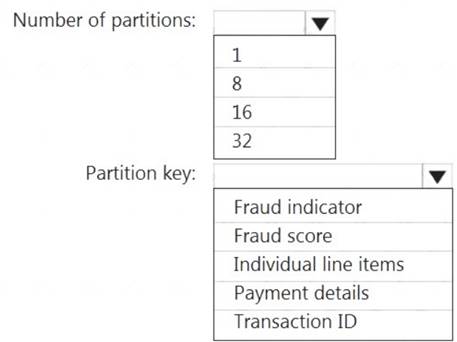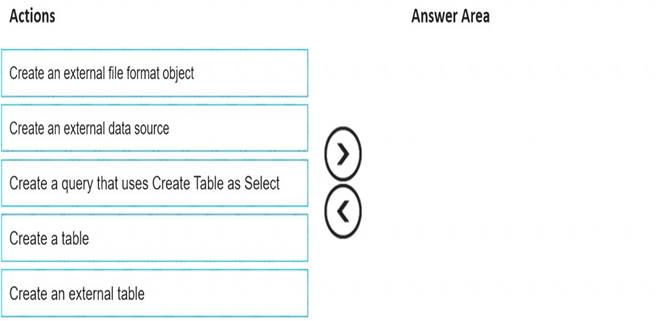- (Exam Topic 3)
You are designing an Azure Databricks cluster that runs user-defined local processes. You need to recommend a cluster configuration that meets the following requirements:
• Minimize query latency.
• Maximize the number of users that can run queues on the cluster at the same time « Reduce overall costs without compromising other requirements
Which cluster type should you recommend?
Correct Answer:
C
A High Concurrency cluster is a managed cloud resource. The key benefits of High Concurrency clusters are that they provide fine-grained sharing for maximum resource utilization and minimum query latencies.
Databricks chooses the appropriate number of workers required to run your job. This is referred to as autoscaling. Autoscaling makes it easier to achieve high cluster utilization, because you don’t need to provision the cluster to match a workload.
Reference:
https://docs.microsoft.com/en-us/azure/databricks/clusters/configure
- (Exam Topic 3)
You are designing an Azure Data Lake Storage solution that will transform raw JSON files for use in an analytical workload.
You need to recommend a format for the transformed files. The solution must meet the following requirements: Contain information about the data types of each column in the files.
Contain information about the data types of each column in the files. Support querying a subset of columns in the files.
Support querying a subset of columns in the files.  Support read-heavy analytical workloads.
Support read-heavy analytical workloads. Minimize the file size.
Minimize the file size.
What should you recommend?
Correct Answer:
D
Parquet, an open-source file format for Hadoop, stores nested data structures in a flat columnar format. Compared to a traditional approach where data is stored in a row-oriented approach, Parquet file format is
more efficient in terms of storage and performance.
It is especially good for queries that read particular columns from a “wide” (with many columns) table since only needed columns are read, and IO is minimized.
Reference: https://www.clairvoyant.ai/blog/big-data-file-formats
- (Exam Topic 3)
You have an Azure event hub named retailhub that has 16 partitions. Transactions are posted to retailhub. Each transaction includes the transaction ID, the individual line items, and the payment details. The transaction ID is used as the partition key.
You are designing an Azure Stream Analytics job to identify potentially fraudulent transactions at a retail store. The job will use retailhub as the input. The job will output the transaction ID, the individual line items, the payment details, a fraud score, and a fraud indicator.
You plan to send the output to an Azure event hub named fraudhub.
You need to ensure that the fraud detection solution is highly scalable and processes transactions as quickly as possible.
How should you structure the output of the Stream Analytics job? To answer, select the appropriate options in the answer area.
NOTE: Each correct selection is worth one point.
Solution:
Box 1: 16
For Event Hubs you need to set the partition key explicitly.
An embarrassingly parallel job is the most scalable scenario in Azure Stream Analytics. It connects one
partition of the input to one instance of the query to one partition of the output. Box 2: Transaction ID
Reference:
https://docs.microsoft.com/en-us/azure/event-hubs/event-hubs-features#partitions
Does this meet the goal?
Correct Answer:
A
- (Exam Topic 3)
You have a SQL pool in Azure Synapse.
A user reports that queries against the pool take longer than expected to complete. You need to add monitoring to the underlying storage to help diagnose the issue.
Which two metrics should you monitor? Each correct answer presents part of the solution. NOTE: Each correct selection is worth one point.
Correct Answer:
AE
A: Cache used is the sum of all bytes in the local SSD cache across all nodes and cache capacity is the sum of the storage capacity of the local SSD cache across all nodes.
E: Cache hits is the sum of all columnstore segments hits in the local SSD cache and cache miss is the columnstore segments misses in the local SSD cache summed across all nodes
Reference:
https://docs.microsoft.com/en-us/azure/synapse-analytics/sql-data-warehouse/sql-data-warehouse-concept-resou
- (Exam Topic 3)
You need to build a solution to ensure that users can query specific files in an Azure Data Lake Storage Gen2 account from an Azure Synapse Analytics serverless SQL pool.
Which three actions should you perform in sequence? To answer, move the appropriate actions from the list of actions to the answer area and arrange them in the correct order.
NOTE: More than one order of answer choices is correct. You will receive credit for any of the correct orders you select.
Solution:
Graphical user interface, text, application, email Description automatically generated
Step 1: Create an external data source
You can create external tables in Synapse SQL pools via the following steps: CREATE EXTERNAL DATA SOURCE to reference an external Azure storage and specify the credential that should be used to access the storage.
CREATE EXTERNAL DATA SOURCE to reference an external Azure storage and specify the credential that should be used to access the storage. CREATE EXTERNAL FILE FORMAT to describe format of CSV or Parquet files.
CREATE EXTERNAL FILE FORMAT to describe format of CSV or Parquet files. CREATE EXTERNAL TABLE on top of the files placed on the data source with the same file format. Step 2: Create an external file format object
CREATE EXTERNAL TABLE on top of the files placed on the data source with the same file format. Step 2: Create an external file format object
Creating an external file format is a prerequisite for creating an external table. Step 3: Create an external table
Reference:
https://docs.microsoft.com/en-us/azure/synapse-analytics/sql/develop-tables-external-tables
Does this meet the goal?
Correct Answer:
A